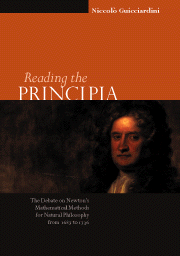 Reading the Principia
Reading the Principia 5 - Huygens: the Principia and proportion theory
Published online by Cambridge University Press: 29 March 2010
Summary
Purpose of this chapter
At the time that Newton's Principia was published, Christiaan Huygens was universally recognized as the greatest authority in natural philosophy and a leading geometer of his age. His work in mathematics, mechanics, technology, astronomy and optics was outstanding. One can enumerate his main contributions: the mathematical treatment of probability, the study of impact laws, the observations of the planetary system, the mathematical treatment of simple and compound pendula, the discovery of the tautochronism of the cycloid, the understanding of conservation laws in dynamics nowadays seen as ‘equivalent’ to energy conservation, the mathematical study of centrifugal force, the wave theory of light and the study of double refraction in a crystal of Iceland spar. This is indeed an impressive list: both Newton and Leibniz declared their indebtedness to the Dutch natural philosopher.
What is perhaps more relevant with Huygens is that he showed how far-reaching could be the use of mathematics in the understanding of natural phenomena. In particular, Huygens' work in mechanics and optics was framed in a highly sophisticated mathematical language. While Galileo's ‘two new sciences’ required relatively simple mathematical tools, while Descartes' ‘natural philosophy’ was mainly qualitative and divorced from mathematics, Huygens' work was heavily mathematical. One of his masterpieces, significantly entitled Horologium oscillatorium, sive de motu pendulorum ad horologia aptato demonstrationes geometricae, published in Paris in 1673, required very complex mathematical techniques. Newton's Principia and Leibniz's dynamical works were written after the example of mathematization of mechanics given in the Horologium, and, despite the numerous differences, both men owed a great deal to this work.
Information
- Type
- Chapter
- Information
- Reading the PrincipiaThe Debate on Newton's Mathematical Methods for Natural Philosophy from 1687 to 1736, pp. 118 - 135Publisher: Cambridge University PressPrint publication year: 1999